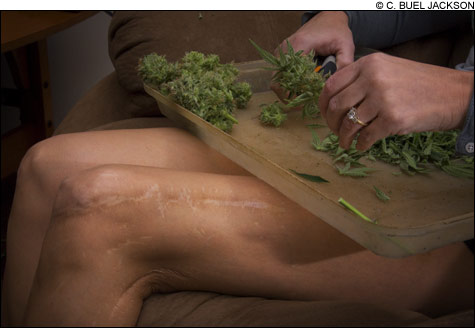Even though it's a crisp November day, the flower boxes of Mary Jones's neat little bungalow are overflowing with brightly colored blooms. The bubbly mother of three has her utility vehicle parked in the driveway. Her hair is perfectly coiffed, her blond highlights glimmer in the late-fall sun. She looks like she could be a real-estate broker, and seeing the rock on her manicured finger, I imagine for a moment that her husband is a doctor or a lawyer. Mary would, in fact, be the ideal soccer mom, except that one of her now-grown sons played football, and rather than working in real estate, she grows and sells marijuana.
She's Boston's own real-life Nancy Botwin, the protagonist of the Showtime dramedy Weeds.
Mary is no small-time peddler simply adding to her income with a $20-bag here or there. She has dozens of plants, which she methodically harvests every eight to 10 days, scattered throughout the house. She sells her crop to a mature, recreational-using clientele.
Nor, however, is she a ruthless street dealer. Instead, she has a bit of a Robin Hood streak — she gives away her product to those in chronic pain or with severely debilitating disease who can't otherwise afford it (even paying for delivery out of her own pocket). In doing so, Mary has signed on to an underground, global anti-pharmaceutical revolution that is gaining traction in this country, one which believes that the natural pain relief of marijuana is substantially more effective and less addictive than FDA-approved painkillers like OxyContin, to which the government, doctors, and Big Pharma typically steer sufferers.
I was first introduced to Mary at a party in Central Square, by a mutual friend. In order for Mary to trust me with her story, our friend had to vouch for me as someone known to be fair and discreet. I then had to agree to keep her identity secret (Mary Jones, as you may have already guessed, is not her real name, and all of the other names in this story have been changed to protect her and their anonymity). Sounds like a simple assignment, right? Not so much. Before meeting with her, for example, the photographer who accompanied me and I had to agree to be blindfolded during the very long drive to Mary's house. (This can be a nerve-racking thing, exponentially more so when you are being blindfolded by a drug dealer you just met.)
I didn't know where we were going, or what to expect when we got there. I had all kinds of questions running through my mind. Would there be guns, angry pit bulls, and large threatening thugs? What if something . . . happened?
But the question that really intrigued me was this: how did a petite, middle-aged, suburban housewife, who only a decade earlier was a fervent anti-smoker, end up as a thriving supplier in the Boston-area marijuana network and a global advocate of using cannabis to treat pain?

GROWTH INDUSTRY: Mary Jones, who suffered a crippling leg injury more than 15 years ago, turned away from prescription drugs and to marijuana to handle her debilitating pain. She then went from suburban mom to lucrative pot dealer, who grows — and sells — her own. |
In the beginning
"I couldn't go anywhere without my pills," explains Mary, fortysomething, remembering a time in her life nearly 15 years ago. "I was at my son's reading group and nodding out."